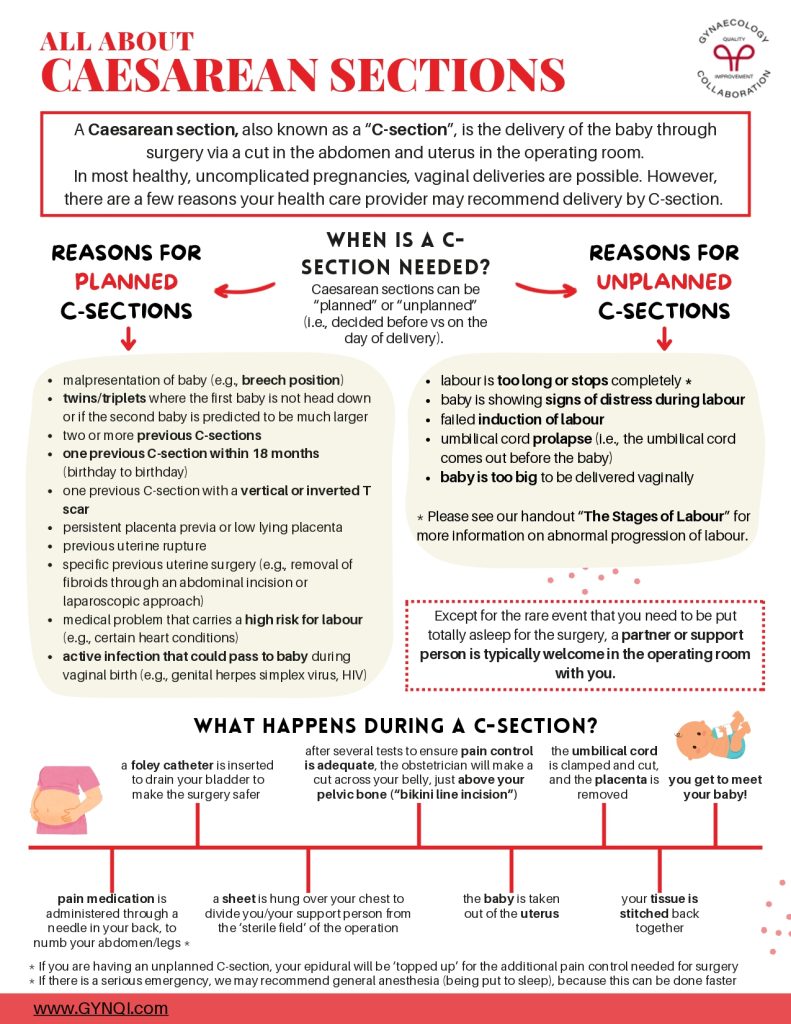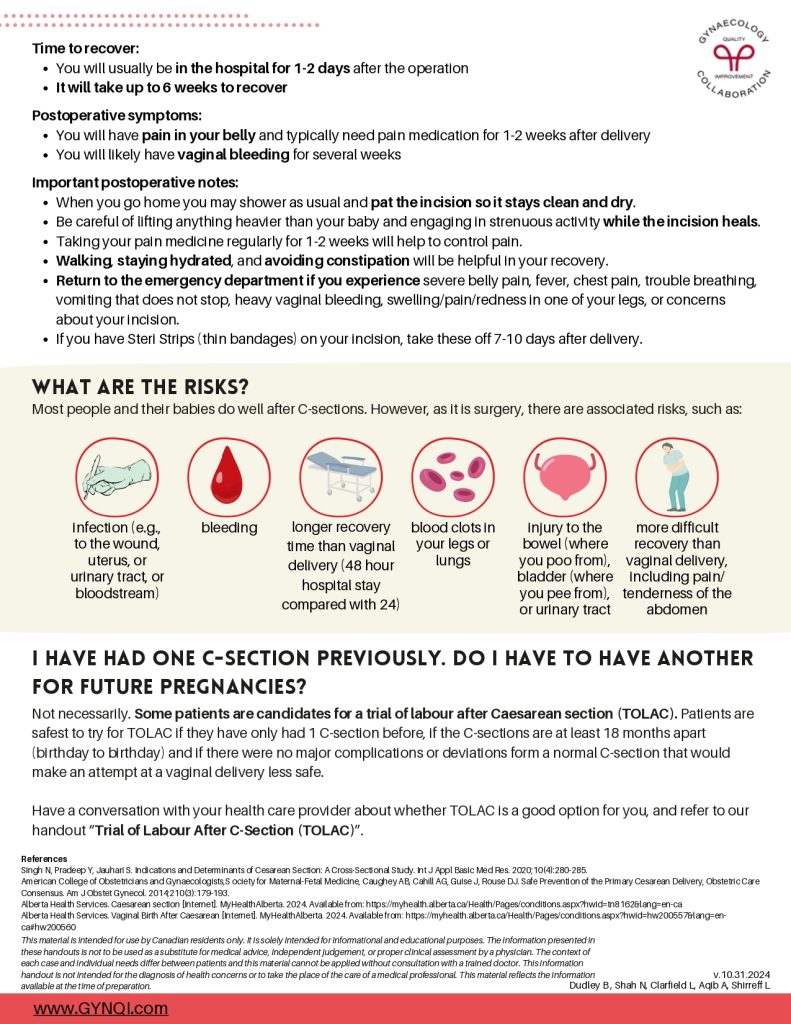
All About Caesarean Sections
A Caesarean section, also known as a “C-section”, is the delivery of the baby through surgery via a cut in the abdomen and uterus in the operating room. In most healthy, uncomplicated pregnancies, vaginal deliveries are possible. However, there are a few reasons your health care provider may recommend delivery by C-section.
When Is A C-Section Needed?
Caesarean sections can be “planned” or “unplanned” (i.e., decided before vs on the day of delivery).
Reasons for Planned C-Sections
- malpresentation of baby (e.g., breech position)
- twins/triplets where the first baby is not head down or if the second baby is predicted to be much larger
- two or more previous C-sections
- one previous C-section within 18 months (birthday to birthday)
- one previous C-section with a vertical or inverted T scar
- persistent placenta previa or low lying placenta
- previous uterine rupture
- specific previous uterine surgery (e.g., removal of fibroids through an abdominal incision or laparoscopic approach)
- medical problem that carries a high risk for labour (e.g., certain heart conditions)
- active infection that could pass to baby during vaginal birth (e.g., genital herpes simplex virus, HIV)
Reasons for Unplanned C-Sections
- labour is too long or stops completely *
- baby is showing signs of distress during labour
- failed induction of labour
- umbilical cord prolapse (i.e., the umbilical cord comes out before the baby)
- baby is too big to be delivered vaginally
* Please see our handout “The Stages of Labour” for more information on abnormal progression of labour.
What Happens During A C-Section?
- pain medication is administered through a needle in your back, to numb your abdomen/legs *
- a foley catheter is inserted to drain your bladder to make the surgery safer
- a sheet is hung over your chest to divide you/your support person from the ‘sterile field’ of the operation
- after several tests to ensure pain control is adequate, the obstetrician will make a cut across your belly, just above your pelvic bone (“bikini line incision”)
- the baby is taken out of the uterus
- the umbilical cord is clamped and cut, and the placenta is removed
- your tissue is stitched back together
- you get to meet your baby!
Except for the rare event that you need to be put totally asleep for the surgery, a partner or support person is typically welcome in the operating room with you.
* If you are having an unplanned C-section, your epidural will be ‘topped up’ for the additional pain control needed for surgery
* If there is a serious emergency, we may recommend general anesthesia (being put to sleep), because this can be done faster
Time to recover:
- You will usually be in the hospital for 1-2 days after the operation
- It will take up to 6 weeks to recover
Postoperative symptoms:
- You will have pain in your belly and typically need pain medication for 1-2 weeks after delivery
- You will likely have vaginal bleeding for several weeks
Important postoperative notes:
- When you go home you may shower as usual and pat the incision so it stays clean and dry.
- Be careful of lifting anything heavier than your baby and engaging in strenuous activity while the incision heals.
- Taking your pain medicine regularly for 1-2 weeks will help to control pain.
- Walking, staying hydrated, and avoiding constipation will be helpful in your recovery.
- Return to the emergency department if you experience severe belly pain, fever, chest pain, trouble breathing, vomiting that does not stop, heavy vaginal bleeding, swelling/pain/redness in one of your legs, or concerns about your incision.
- If you have Steri Strips (thin bandages) on your incision, take these off 7-10 days after delivery.
What Are the Risks?
Most people and their babies do well after C-sections. However, as it is surgery, there are associated risks, such as:
- infection (e.g., to the wound, uterus, or urinary tract, or bloodstream)
- bleeding
- longer recovery time than vaginal delivery (48 hour hospital stay compared with 24)
- blood clots in your legs or lungs
- injury to the bowel (where you poo from), bladder (where you pee from), or urinary tract
- more difficult recovery than vaginal delivery, including pain/ tenderness of the abdomen
I Have Had One C-Section Previously. Do I Have to Have Another for Future Pregnancies?
Not necessarily. Some patients are candidates for a trial of labour after Caesarean section (TOLAC). Patients are safest to try for TOLAC if they have only had 1 C-section before, if the C-sections are at least 18 months apart (birthday to birthday) and if there were no major complications or deviations form a normal C-section that would make an attempt at a vaginal delivery less safe.
Have a conversation with your health care provider about whether TOLAC is a good option for you, and refer to our handout “Trial of Labour After C-Section (TOLAC)”.




